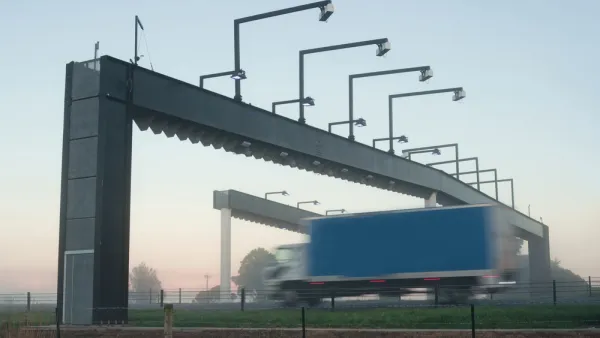Delays in constructing an extensive truck-only toll system have caused a shortfall in toll revenue affecting the Rhode Island DOT budget. A promise to repair bridges repair means a big cut for bike and pedestrian funding.

"The Rhode Island Department of Transportation [RIDOT] has proposed cutting $28 million from bicycle and pedestrian projects and trimming $96 million from its highway repaving budget over the next decade in the most recent changes to its 10-year transportation spending plan," reports Patrick Anderson for the Providence Journal.
The changes, which have drawn the ire of advocates for improved bicycle and pedestrian infrastructure, will allow the state to keep the promise it made when lawmakers approved truck tolls in 2015 [sic], to have 90 percent of the state’s highway bridges structurally sufficient by 2025. Currently, 77 percent of Rhode Island’s bridges are rated structurally sufficient.
At the time, the Ocean State had the dubious distinction of having the highest percentage of state bridges, 56 percent, being rated deficient, which includes both structurally deficient and functionally obsolete categories. Finding revenue to repair bridges was one of the main reasons that led the state legislature in February 2016 to approve Gov. Gina Raimondo's truck-only toll program, known as RhodeWorks.
The unique tolling program, which only applies to specific types of tractor trailers and relies on electronic toll collection as opposed to toll booths, became operational in June 2018, "roughly a year later than first anticipated — due to a more time-consuming federal approval process and toll-equipment testing," reports Anderson, and that means a shortfall of projected toll revenue.
Furthermore, only two of the 13 planned toll gantries have been constructed and are operational, but the department received good news from the federal government in December.
"RIDOT announced Dec. 20 that the Federal Highway Administration has granted approval for the state to proceed with construction on another series of tolling gantries," reported Eleanor Lamb for Transport Topics.
According to RIDOT, the next tolling gantry is expected to be completed and operational by May. The remaining tolling locations will be activated “in quick succession” every one or two months. The 10 gantries are expected to be completed by May 2020.
Diversion of federal active transportation funding
According to Angie Schmitt of Streetsblog USA, RIDOT chose to "transfer $27 million in federal money dedicated to active transportation to highways and administrative expenses over the next 10 years."
The transfer will rob funding from City Walk, the innovative on-road trail project underway in Providence aimed at increasing walking and biking rates and improving safety.
The Rhode Island Bicycle Coalition has issued a "call to action" to its members to restore funds to the Transportation Alternatives Program.
"We object, in the strongest possible terms, to the amendment proposed by the Rhode Island Department of Transportation," states their Jan. 26 press release.
Funds in the Transportation Alternatives Program should not be raided for highway infrastructure projects or other priorities. Rhode Island’s citizens deserve better.
FULL STORY: R.I. truck-toll delays are cutting into funds for DOT projects

National Parks Layoffs Will Cause Communities to Lose Billions
Thousands of essential park workers were laid off this week, just before the busy spring break season.

Retro-silient?: America’s First “Eco-burb,” The Woodlands Turns 50
A master-planned community north of Houston offers lessons on green infrastructure and resilient design, but falls short of its founder’s lofty affordability and walkability goals.

Delivering for America Plan Will Downgrade Mail Service in at Least 49.5 Percent of Zip Codes
Republican and Democrat lawmakers criticize the plan for its disproportionate negative impact on rural communities.

Test News Post 1
This is a summary

Test News Headline 46
Test for the image on the front page.

Balancing Bombs and Butterflies: How the National Guard Protects a Rare Species
The National Guard at Fort Indiantown Gap uses GIS technology and land management strategies to balance military training with conservation efforts, ensuring the survival of the rare eastern regal fritillary butterfly.
Urban Design for Planners 1: Software Tools
This six-course series explores essential urban design concepts using open source software and equips planners with the tools they need to participate fully in the urban design process.
Planning for Universal Design
Learn the tools for implementing Universal Design in planning regulations.
EMC Planning Group, Inc.
Planetizen
Planetizen
Mpact (formerly Rail~Volution)
Great Falls Development Authority, Inc.
HUDs Office of Policy Development and Research
NYU Wagner Graduate School of Public Service



























